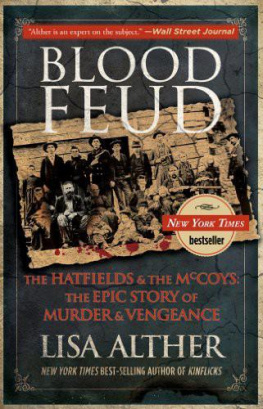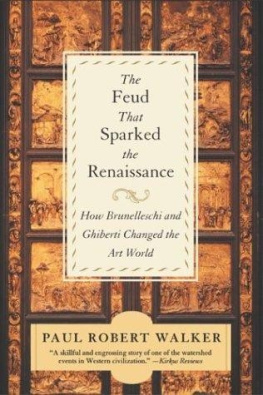1988 The University of North Carolina Press
All rights reserved
Manufactured in the United States of America
The paper in this book meets the guidelines for permanence and durability of the Committee on Production Guidelines for Book Longevity of the Council on Library Resources.
00 99 98 97 96 8 7 6 5 4
Library of Congress Cataloging-in-Publication Data Waller, Altina L. (Altina Laura), 1940-Feud: Hatfields, McCoys, and social change in Appalachia, 18601900 / by Altina L. Waller.
p. cm.(The Fred W. Morrison series in Southern studies)
Bibliography: p.
Includes index.
ISBN 0-8078-1770-8 (alk. paper)
ISBN 0-8078-4216-8 (pbk.: alk. paper)
I. Hatfield-McCoy feud. 2. Appalachian Region, SouthernSocial conditions. I. Title. II. Series.
HV6452.A128W35 1988 87-26567
975.4404de 19 CIP
THIS BOOK WAS DIGITALLY PRINTED.
Maps and Tables
MAPS
1. Logan and Pike Counties /
2. The Tug Valley /
TABLES
1. Population Growth in Pike and Logan Counties, 18301890 /
2. Kin and Economic Relationship of Hatfield Supporters to Devil Anse /
3. Families without Land: Comparison of Hatfield Feudists to Logan County /
4. Residence Patterns of Second-Phase Feudists /
5. Age Distribution of Feudists /
6. Wealth Distribution of Feudists /
7. Personal Property Distribution of Feudists /
Acknowledgments
The Hatfields and the McCoys have been part of my life for almost ten years now, and I have come to think of them as friends and neighbors whose defeats and triumphs have some meaning for my life as well as theirs. Although most of my knowledge of them comes from the faded and impersonal documents in county court-houses, I have also driven the mountain roads that they so often traversed on their way to those courthouses, climbed the steep mountain slopes where they buried their dead, and walked along Grapevine Creek where they fought their final battle. In the process of trying to understand what they were like and what the feud was about I have come to admire some and dislike others, but mostly I am grateful to them for teaching me something about a culture so different from my own.
The Hatfields and McCoys first came into my life when I left graduate study in Massachusetts to take my first job at West Virginia University in Morgantown. Although I did not yet know much about Appalachian history, I owe my preparation for taking on that new subject to my training in social history at the University of Massachusetts at Amherst. It was my advisor, Professor Stephen Nissenbaum, who taught me how to think about history, and even though he was never directly involved in this project it nevertheless owes much to him.
My research on the feud was originally undertaken in preparation for teaching a course at West Virginia University. It was during those first explorations in the Pike and Logan county courthouses that I began to realize what a wealth of untapped sources existed, not only for the feud itself, but for the feudists community in the Tug River Valley. It was quickly apparent that not only was there more than enough material for a book, but that book would provide a whole new interpretation of the feud and its relationship to the social and economic transformation of the region.
As I began to delve into Appalachian history, my thinking was guided by experienced scholars in the field, some of whom I came to know personally and others whose works I read and savored. First among them was John Alexander Williams, whose chapter, Tug Fork, in West Virginia sent me off in what turned out to be the correct intellectual direction. More recently he read the final manuscript, offering invaluable suggestions and saving me from embarrassing errors. Others who have influenced my thinking in the direction of Appalachian revisionism are Ron Eller, Gordon McKinney, and John Gaventa. David Whisnant, whose own work has given me considerable insight, read an earlier paper as well as the final manuscript and provided much-needed encouragement.
The research phase of my work was enhanced by the hospitality I encountered at the Logan County Courthouse, the state archives in Charleston, West Virginia, the University of Kentucky Library in Lexington, and the archives at West Virginia University. Since the bulk of my time was spent in the Logan County Courthouse, I wish to thank especially Victoria Bayliss of the county clerks office and all those who helped me find obscure items, make copies, and gain access to the basement storeroom. Even so, the research could not have gone so smoothly without the assistance of Bradley Pyles, a Logan lawyer and a dear friend, who not only helped me find materials but also spent many hours translating the nineteenth-century legalese that threatened to confound me completely. Most of all he, more than anyone else, provided insights into the Appalachia of today and the working people he serves with so much energy and dedication. Brads name appears nowhere in the footnotes, but to him is owed one of this books greatest debts. In the final stages of my research, several people in both Pike and Logan counties gave more than generously of their time and wisdom in the often frustrating process of locating illustrations and old photographs. My deepest appreciation goes to Sadie McCoy of Phelps, Kentucky, Dorcas Hobbs of Pikeville, Kentucky, and Robert Y. Spence of Logan, West Virginia.
Valuable assistance has always been forthcoming from members of my family. In the early stages of the research, I was accompanied to Logan and Pikeville by my son, Andrew, who shared the search for documents and cheerfully copied endless pages of tax and deed records when there was no copying machine available or affordable. More recently he has contributed his superb skills as an editor of the manuscriptan effort I consider quite an honor coming from a very fine (and published) poet. My daughter, Laura, though less involved with this book than with my previous one, has read and edited parts of the manuscript with sensitivity and intelligence. But the most important contribution of both my children is their consistent love, support, and encouragement in whatever I choose to undertake.
With the documents collected in Pike and Logan counties, I have taught courses on the feud on four occasions: twice at West Virginia University; once at Southwestern at Memphis (now Rhodes College); and once at the State University of New York at Plattsburgh. With all those students I shared the excitement of discovery as together we extracted the story of the feud community from a difficult and complex set of sources. I only hope the experience has benefited them as much as it has me.
The most difficult part of finishing this project was finding an extended block of time for the actual writing of the book. Just at the point when I began to despair of ever having such time, I received a fellowship from the National Endowment for the Humanities for an entire year in 198485. Because of that fellowship, this book was finally brought to fruition.
Finally, I wish to thank my best friend and lifes partner, Miles Martin. But that really has nothing to do with the book. Even if he had never put in hours of research at the West Virginia State Archives, the Kentucky State Archives, the Mormon Library in Albany, and the Logan Circuit Courts office; or spent hours talking out possible interpretations of the evidence; or read and reread the manuscript; or given a week of his life to transferring the manuscript from one computer system to another; or cooked meals and cleaned house when I was too preoccupied to bother with such things, I would still be grateful for the deep and abiding joy that our life together has become.







